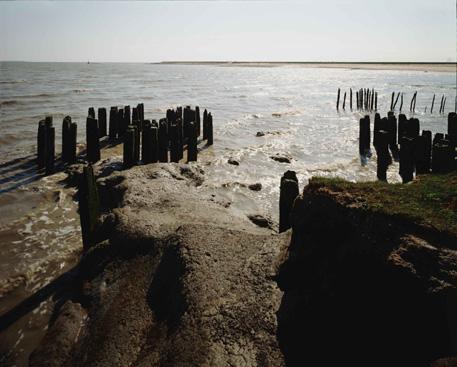
Photograph copyright ©1999 - 2018 Denis Waugh.
External Links
ALLHALLOWS
How to decide where the search ends? Looking for the Thames Estuary, one can keep going east seemingly forever and be tempted to include more and more. Over there, on the northern bank, past Southend, are Maplin Sands and Foulness island. Out here to our right is the Isle of Grain and Sheerness and the Medway, and - enough. Here on the south we are at Allhallows, noted mainly for a caravan park, inexpensive seaside holidays for young London families and a pub selling average beer and inordinately good sandwiches. And this is the lowest reach of the Thames. Official.
But is it the end of the journey? After your average beer and extraordinary sandwich, walk out over the two stiles and past the frisky young bullocks. Be nice to them - life is not going to offer them much, despite their sweet faces and friendly dispositions. Today they seem to have a game under way. First, they all form a queue and follow any random group of walkers until they reach the stile near the pub. Then they all turn around and like cheeky children run hell-for-leather (although the expression is an unfortunate one, given their future) towards the opposite gate. Nothing seems to be driving them and nothing is happening there. They stop, turn and tear off to the right. It is as if a rumour has gone round that one of the gates is open, but no one is going to tell them which one it is.
Far across the mudflats to the right, towards the Isle of Grain, a tiny lighthouse denotes the beginning of the shipping channel. Further inland, on the marshes, is a warning beacon. Across the dykes, rich Kentish pasture land supports healthy looking cattle, sheep and horses and here, on the marsh, numerous wooden piles in divers locations signify that the tiny channel negotiable by ad hoc stepping stones has been at one - or various - times used by boats.
Allhallows. Whilst Essex, across the Thames was obdurately pagan, surely there has never been so Christian a county as Kent. `Not Angles but angels,' murmured Pope Gregory, seeing fair-haired children for sale in the Roman marketplace, and he despatched the reluctant St Augustine here to the farthest outreach of the Roman church, where the influence of the Roman occupation was fast disappearing, to gather the Anglo-Saxons into the flock.
From Gaul, Augustine sent a last plea to Gregory to reconsider. He was a Benedictine, not a missionary, and he didn't want to go to the edge of the world. But Gregory stood firm, and the justification was the baptism on Christmas Day 598 of ten thousand Kentish souls.
Now it is a haven for birds. Sandpipers, plover, redshanks and a variety of other waders take off in high dudgeon as you walk over the shelly sand. The marshes are worth a visit for their own sake. Take a day out here, to walk and watch the oystercatcher and the dunlin going about their daily work.
How many have walked here or sailed past this spot? Kings, emperors and refugees; slaves, soldiers and princes; royal brides, Christian missionaries and Vikings. An extraordinary variety of races and beliefs, each making its unique contribution to what we fondly like to imagine the `pure' English race.
Just stop for a while and listen: to the birds and to the past. Can you hear the faint chanting of plainsong? The plash of galley oars? Can you sense the presence of St Augustine? Of Hengist and Horsa, leading the first Anglo Saxons? Of Harold Godwinson? William the Bastard? Pip and Magwich? Little of a concrete nature remains here to tell us of the people who journeyed through the centuries where we journey today, but just listen.
And what has it all been about, the search? In the silence of the marshes you could be tempted to think, just for an instant, that you almost understand... and then, in another instant, it is gone. But surely it is still there. Just listen.
Text copyright ©1999 - 2018 Priscilla Waugh.